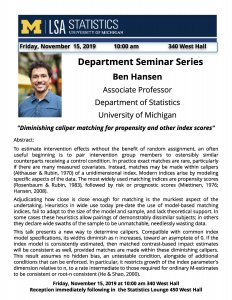Presented By: Department of Statistics
Statistics Department Seminar Series: Ben Hansen, Associate Professor, Department of Statistics, University of Michigan
"Diminishing caliper matching for propensity and other index scores"

To estimate intervention effects without the benefit of random assignment, an often useful beginning is to pair intervention group members to ostensibly similar counterparts receiving a control condition. In practice exact matches are rare, particularly if there are many measured covariates. Instead, matches may be made within calipers (Althauser & Rubin, 1970) of a unidimensional index. Modern indices arise by modeling specific aspects of the data. The most widely used matching indices are propensity scores (Rosenbaum & Rubin, 1983), followed by risk or prognostic scores (Miettinen, 1976; Hansen, 2008).
Adjudicating how close is close enough for matching is the murkiest aspect of the undertaking. Heuristics in wide use today pre-date the use of model-based matching indices, fail to adapt to the size of the model and sample, and lack theoretical support. In some cases these heuristics allow pairings of demonstrably dissimilar subjects; in others they declare wide swaths of the sample to be unmatchable, needlessly wasting data.
This talk presents a new way to determine calipers. Compatible with common index model specifications, its widths diminish as n increases, toward an asymptote of 0. If the index model is consistently estimated, then matched contrast-based impact estimates will be consistent as well, provided matches are made within these diminishing calipers. This result assumes no hidden bias, an untestable condition, alongside of additional conditions that can be enforced. In particular, it restricts growth of the index parameter's dimension relative to n, to a rate intermediate to those required for ordinary M-estimates to be consistent or root-n consistent (He & Shao, 2000).
Adjudicating how close is close enough for matching is the murkiest aspect of the undertaking. Heuristics in wide use today pre-date the use of model-based matching indices, fail to adapt to the size of the model and sample, and lack theoretical support. In some cases these heuristics allow pairings of demonstrably dissimilar subjects; in others they declare wide swaths of the sample to be unmatchable, needlessly wasting data.
This talk presents a new way to determine calipers. Compatible with common index model specifications, its widths diminish as n increases, toward an asymptote of 0. If the index model is consistently estimated, then matched contrast-based impact estimates will be consistent as well, provided matches are made within these diminishing calipers. This result assumes no hidden bias, an untestable condition, alongside of additional conditions that can be enforced. In particular, it restricts growth of the index parameter's dimension relative to n, to a rate intermediate to those required for ordinary M-estimates to be consistent or root-n consistent (He & Shao, 2000).